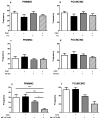Amphetamine and cocaine suppress social play behavior in rats through distinct mechanisms
- PMID: 24057815
- PMCID: PMC3962711
- DOI: 10.1007/s00213-013-3272-9
Amphetamine and cocaine suppress social play behavior in rats through distinct mechanisms
Abstract
Rationale: Social play behavior is a characteristic form of social behavior displayed by juvenile and adolescent mammals. This social play behavior is highly rewarding and of major importance for social and cognitive development. Social play is known to be modulated by neurotransmitter systems involved in reward and motivation. Interestingly, psychostimulant drugs, such as amphetamine and cocaine, profoundly suppress social play, but the neural mechanisms underlying these effects remain to be elucidated.
Objective: In this study, we investigated the pharmacological underpinnings of amphetamine- and cocaine-induced suppression of social play behavior in rats.
Results: The play-suppressant effects of amphetamine were antagonized by the alpha-2 adrenoreceptor antagonist RX821002 but not by the dopamine receptor antagonist alpha-flupenthixol. Remarkably, the effects of cocaine on social play were not antagonized by alpha-2 noradrenergic, dopaminergic, or serotonergic receptor antagonists, administered either alone or in combination. The effects of a subeffective dose of cocaine were enhanced by a combination of subeffective doses of the serotonin reuptake inhibitor fluoxetine, the dopamine reuptake inhibitor GBR12909, and the noradrenaline reuptake inhibitor atomoxetine.
Conclusions: Amphetamine, like methylphenidate, exerts its play-suppressant effect through alpha-2 noradrenergic receptors. On the other hand, cocaine reduces social play by simultaneous increases in dopamine, noradrenaline, and serotonin neurotransmission. In conclusion, psychostimulant drugs with different pharmacological profiles suppress social play behavior through distinct mechanisms. These data contribute to our understanding of the neural mechanisms of social behavior during an important developmental period, and of the deleterious effects of psychostimulant exposure thereon.
Figures






References
-
- Aston-Jones G, Cohen JD. An integrative theory of locus coeruleus-norepinephrine function: Adaptive gain and optimal performance. Annu Rev Neurosci. 2005;28:403–450. - PubMed
-
- Beatty WW, Costello KB, Berry SL. Suppression of play fighting by amphetamine: effects of catecholamine antagonists, agonists and synthesis inhibitors. Pharmacol Biochem Behav. 1984;20:47–755. - PubMed
-
- Beatty WW, Dodge AM, Dodge LJ, Panksepp J. Psychomotor stimulants, social deprivation and play in juvenile rats. Pharmacol Biochem Behav. 1982;16:417–422. - PubMed
Publication types
MeSH terms
Substances
Grants and funding
LinkOut - more resources
Full Text Sources
Other Literature Sources

